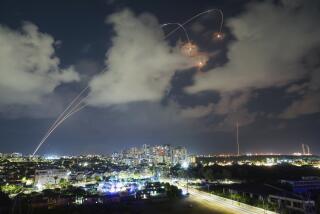A Misdirected Missile Defense Plan
The limited National Missile Defense system that Congress last year ordered deployed “as soon as technologically possible” is looking less limited all the time.
In a new study, the nonpartisan Congressional Budget Office projects that NMD’s first phase will cost just under $30 billion through 2015, billions more than the Pentagon’s estimate. That price would double, and the system would greatly expand, if two projected additional phases are added. It could be argued that $60 billion is a small price to pay for protecting the whole of the United States against missiles armed with nuclear, chemical or biological warheads. The price is reasonable, however, only if it buys a system that works. The CBO, along with others, including Phillip E. Coyle, the Defense Department’s chief testing analyst, cautions that NMD’s effectiveness is far from proven.
The Pentagon’s Ballistic Missile Defense Organization says the first phase of NMD is designed to defend against attack by “a few simple” warheads. For that, 100 interceptors would be based in Alaska, a sophisticated new radar system would have to be built, and older early-warning radar would have to be upgraded.
Phase 2 would aim at defending against “a few complex” warheads, mainly by expanding the radar system. Phase 3 looks to dealing with “many complex” warheads by adding 150 interceptors, most to be based in North Dakota, and further expanding necessary radar and communications systems. Proceeding only with NMD’s first phase would require Russia’s agreement to amend the 1972 Anti-Ballistic Missile Treaty, or a U.S. decision to abrogate the pact.
So far, only two test interceptor missiles have been fired. One failed, and the other hit an incoming warhead. A third test is scheduled for June 26, after which the Pentagon is to recommend to President Clinton whether to proceed with deployment. But even a successful test would leave crucial technical problems unresolved.
Example one: The system can’t differentiate between real and decoy warheads. As the CBO rightly points out, a country that knows how to launch an intercontinental missile with a warhead capable of killing hundreds of thousands of people also knows about decoys.
Example two: The interceptor used in the test firings won’t be the interceptor actually deployed. The eventual booster will subject the warhead to 10 times more high-frequency vibrations than the test flight rocket. That, the CBO says, could “distort or damage the kill vehicle’s optics or electronics, rendering the interceptor impotent.”
This all adds up to an overwhelming case for moving cautiously with this unproven and expensive venture. More time is needed, as the CBO says, to develop the technology needed to discriminate between real warheads and decoys. And certainly a more thoughtful examination of the strategic and political consequences of NMD deployment has to be undertaken.
Russia has hinted that it might abandon all strategic arms agreements if NMD goes ahead. The great danger in that event is not so much from Russia’s thousands of remaining missiles and warheads but from the risk that Moscow would peddle its missile and weapons technology to others, including North Korea, Iran and Iraq. In that event, the security threats to the United States would be multiplied many times over. That contingency should give pause even to those who so heedlessly dismiss Russia’s response to NMD as of no consequence.
More to Read
Sign up for Essential California
The most important California stories and recommendations in your inbox every morning.
You may occasionally receive promotional content from the Los Angeles Times.










